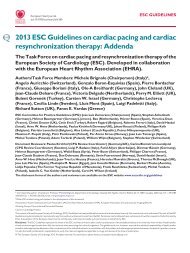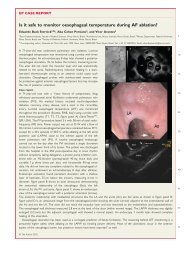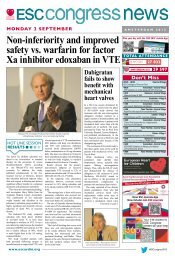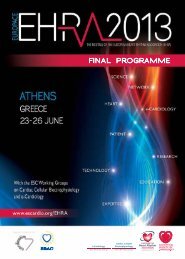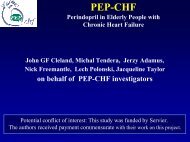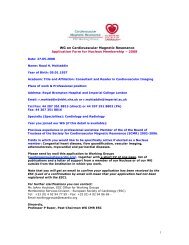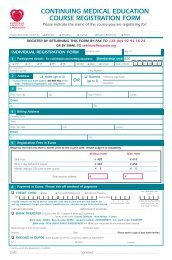EHS on Stable angina - Main publication - European Society of ...
EHS on Stable angina - Main publication - European Society of ...
EHS on Stable angina - Main publication - European Society of ...
You also want an ePaper? Increase the reach of your titles
YUMPU automatically turns print PDFs into web optimized ePapers that Google loves.
Page 2 <strong>of</strong> 12 C.A. Daly et al.<br />
Introducti<strong>on</strong><br />
The management <strong>of</strong> stable <strong>angina</strong> has two major objectives:<br />
to reduce or abolish the symptoms, and to<br />
improve prognosis. Some treatment opti<strong>on</strong>s have a well<br />
proven track record in achieving both aims; for example,<br />
revascularizati<strong>on</strong> in anatomically defined subgroups 1–4 or<br />
beta-blockade in the post-myocardial infarcti<strong>on</strong> (MI) populati<strong>on</strong>,<br />
5 but many sec<strong>on</strong>dary preventi<strong>on</strong> measures do not<br />
reduce symptoms. This absence <strong>of</strong> a direct effect <strong>on</strong> symptoms<br />
does not, however, diminish the importance <strong>of</strong> antiplatelet<br />
therapy and lipid-lowering therapy, particularly<br />
statin therapy, which should be universally prescribed<br />
in patients with clinically suspected cor<strong>on</strong>ary disease<br />
provided there are no c<strong>on</strong>traindicati<strong>on</strong>s, 6–8 and possibly<br />
also angiotensin c<strong>on</strong>verting enzyme (ACE) inhibitor<br />
therapy. 9,10 After such blanket sec<strong>on</strong>dary preventi<strong>on</strong><br />
therapy, treatment opti<strong>on</strong>s diversify rapidly and should<br />
be guided by clinical characteristics <strong>of</strong> the patient, including<br />
cardiovascular and n<strong>on</strong>-cardiovascular co-morbidity,<br />
patient tolerance, and patient preference.<br />
With regard to pharmacological treatment <strong>of</strong> <strong>angina</strong>,<br />
there are innumerable studies <strong>of</strong> the effect <strong>of</strong> comm<strong>on</strong><br />
anti-<strong>angina</strong>l drug classes (beta-blockers, calcium antag<strong>on</strong>ists,<br />
and nitrates), or combinati<strong>on</strong>s there<strong>of</strong>, <strong>on</strong> either<br />
symptoms or markers <strong>of</strong> ischaemia, silent or symptomatic,<br />
ambulatory or provoked. 7,11–13 Yet despite the<br />
high prevalence <strong>of</strong> <strong>angina</strong> and frequent need for anti<strong>angina</strong>l<br />
drug therapy, there are relatively few studies <strong>of</strong><br />
the prognostic effect <strong>of</strong> anti-<strong>angina</strong>l drug therapy, and<br />
even fewer with l<strong>on</strong>g-term follow-up. Beta-blockers are<br />
recommended as first line maintenance 6–8<br />
However, when restricted to patients with cor<strong>on</strong>ary disease documented within 4 weeks<br />
<strong>of</strong> assessment, over 50% had revascularizati<strong>on</strong> performed or planned. Am<strong>on</strong>g other<br />
factors, the nati<strong>on</strong>al rate <strong>of</strong> angiography and availability <strong>of</strong> invasive facilities significantly<br />
predicted the likelihood <strong>of</strong> revascularizati<strong>on</strong>, OR 2.4 and 2.0, respectively.<br />
C<strong>on</strong>clusi<strong>on</strong> This survey shows a shortfall between guidelines and practice with regard to<br />
the use <strong>of</strong> evidence-based drug therapy and evidence that revascularizati<strong>on</strong> rates are<br />
str<strong>on</strong>gly influenced by n<strong>on</strong>-clinical, in additi<strong>on</strong> to clinical, factors.<br />
therapy<br />
(after pro re nata nitrate) for patients with stable<br />
<strong>angina</strong> <strong>on</strong> the basis <strong>of</strong> results from post-MI studies<br />
extrapolated to the stable <strong>angina</strong> populati<strong>on</strong>.<br />
The 1997 <strong>European</strong> guidelines <strong>on</strong> the management <strong>of</strong><br />
<strong>angina</strong> suggest that revascularizati<strong>on</strong> should be c<strong>on</strong>sidered<br />
in patients who will benefit prognostically, 1–4 or in whom<br />
symptoms are not c<strong>on</strong>trolled by medical therapy.<br />
The purpose <strong>of</strong> this survey was to examine the initial<br />
management <strong>of</strong> newly presenting stable <strong>angina</strong> in its<br />
totality, including the adherence to guidelines and<br />
evidence-based practice in the pharmacological treatment<br />
<strong>of</strong> <strong>angina</strong>, and to attempt to examine some <strong>of</strong> the<br />
factors predictive <strong>of</strong> the decisi<strong>on</strong> to revascularize.<br />
Methods<br />
The methodology <strong>of</strong> the Euro Heart Survey (<str<strong>on</strong>g>EHS</str<strong>on</strong>g>) <strong>of</strong> <strong>Stable</strong> Angina<br />
is described in the compani<strong>on</strong> paper. 14 Briefly, to ensure that the<br />
populati<strong>on</strong> studied was representative <strong>of</strong> the stable <strong>angina</strong> populati<strong>on</strong>,<br />
and not a pre-selected group <strong>of</strong> stable patients admitted<br />
to hospital for catheterizati<strong>on</strong> or revascularizati<strong>on</strong>, the survey<br />
was performed <strong>on</strong> community-based patients presenting to a<br />
cardiologist as an outpatient. Participating centres (197) were<br />
a mix <strong>of</strong> academic and n<strong>on</strong>-academic instituti<strong>on</strong>s, and hospitals<br />
with and without interventi<strong>on</strong>al and cardiac surgical facilities.<br />
The patient populati<strong>on</strong> was composed <strong>of</strong> patients at a new<br />
presentati<strong>on</strong> to a cardiologist in whom a diagnosis was made <strong>of</strong><br />
stable <strong>angina</strong>, caused by myocardial ischaemia due to cor<strong>on</strong>ary<br />
disease based <strong>on</strong> clinical assessment, and who did not have<br />
unstable <strong>angina</strong>. A new presentati<strong>on</strong> was defined as a first ever<br />
presentati<strong>on</strong> to a cardiologist, or new referral or re-referral<br />
after a period <strong>of</strong> at least 1 year <strong>of</strong> not attending (c<strong>on</strong>sulting) a<br />
cardiologist. Patients who required hospitalizati<strong>on</strong> within 24 h<br />
<strong>of</strong> the initial c<strong>on</strong>sultati<strong>on</strong>, and were therefore c<strong>on</strong>sidered<br />
likely to have unstable <strong>angina</strong> in a proporti<strong>on</strong> <strong>of</strong> cases, were<br />
excluded from the survey, as were patients who had a prior<br />
history <strong>of</strong> revascularizati<strong>on</strong>, either percutaneous or surgical, or<br />
aetiology other than cor<strong>on</strong>ary disease, for example significant<br />
aortic stenosis, or hypertrophic cardiomyopathy. For all patients,<br />
the immediate medical treatment recommended, and follow-up<br />
arrangements were recorded. Anti-<strong>angina</strong>l drugs were defined as<br />
drugs intended to alleviate symptoms or ischaemia, such as betablockers,<br />
calcium antag<strong>on</strong>ists, nitrates, nicorandil, or metabolic<br />
agents such as trimetazidine. In the case <strong>of</strong> guideline recommended<br />
treatments (anti-platelet therapy, statin therapy,<br />
and beta-blockade) not being prescribed, the investigator was<br />
asked to select a reas<strong>on</strong> why the drug was not prescribed. The<br />
results <strong>of</strong> investigati<strong>on</strong>s performed, and changes to the initial<br />
management plan, including revascularizati<strong>on</strong> procedures performed<br />
or planned, were also recorded 4 weeks after assessment.<br />
Data management<br />
The data were collected electr<strong>on</strong>ically by the investigators and<br />
stored centrally at the <strong>European</strong> <strong>Society</strong> <strong>of</strong> Cardiology based in<br />
Nice, France. The data collecti<strong>on</strong> s<strong>of</strong>tware ran initial c<strong>on</strong>sistency<br />
checks at data entry level, with further checking performed<br />
by submitting the database to c<strong>on</strong>sistency checks as<br />
per a pre-written validati<strong>on</strong> plan using SAS s<strong>of</strong>tware. Missing or<br />
inc<strong>on</strong>sistent values were thus highlighted automatically and<br />
queried by the data management team using ph<strong>on</strong>e or e-mail<br />
c<strong>on</strong>tact with the investigators.<br />
Statistical analysis<br />
Regi<strong>on</strong>al analyses <strong>of</strong> treatment initiated were performed according<br />
to the North, West, Central, and Mediterranean divisi<strong>on</strong>s as<br />
previously used in <str<strong>on</strong>g>EHS</str<strong>on</strong>g> methodology. Descriptive statistics were<br />
used to quantify the frequency <strong>of</strong> use <strong>of</strong> pharmacological and<br />
other treatments at presentati<strong>on</strong>. The Student’s t-test or<br />
ANOVA technique were used as appropriate to test differences<br />
in quantitative measures, and the x 2 test was used to test





